engine SSANGYONG TURISMO 2013 Service Manual
[x] Cancel search | Manufacturer: SSANGYONG, Model Year: 2013, Model line: TURISMO, Model: SSANGYONG TURISMO 2013Pages: 796, PDF Size: 78.99 MB
Page 121 of 796
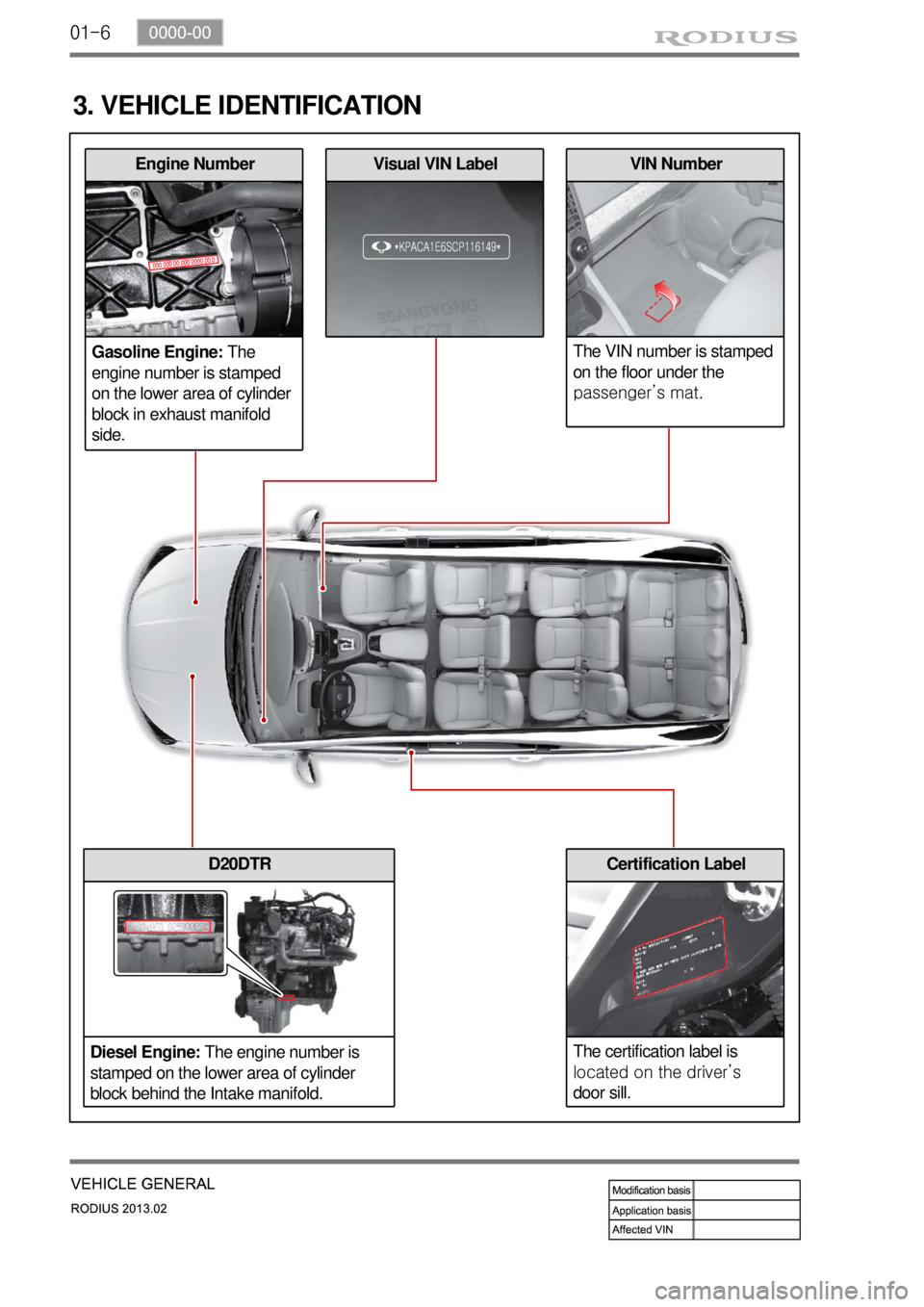
01-6
D20DTR
Diesel Engine: The engine number is
stamped on the lower area of cylinder
block behind the Intake manifold.
Visual VIN LabelEngine Number
Gasoline Engine: The
engine number is stamped
on the lower area of cylinder
block in exhaust manifold
side.VIN Number
The VIN number is stamped
on the floor under the
passenger’s mat.
Certification Label
The certification label is
located on the driver’s
door sill.
3. VEHICLE IDENTIFICATION
Page 122 of 796
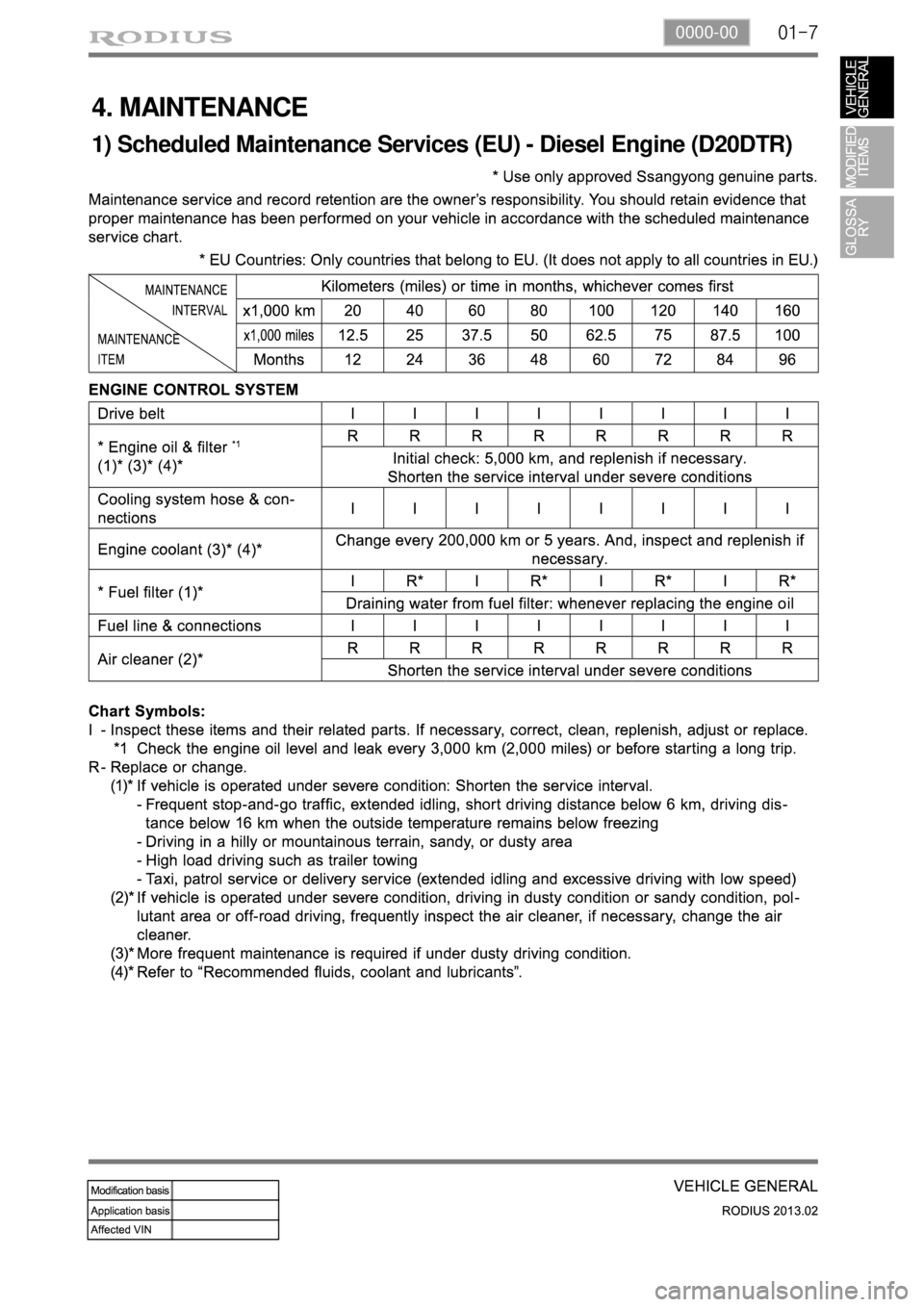
01-70000-00
4. MAINTENANCE
1) Scheduled Maintenance Services (EU) - Diesel Engine (D20DTR)
Page 125 of 796
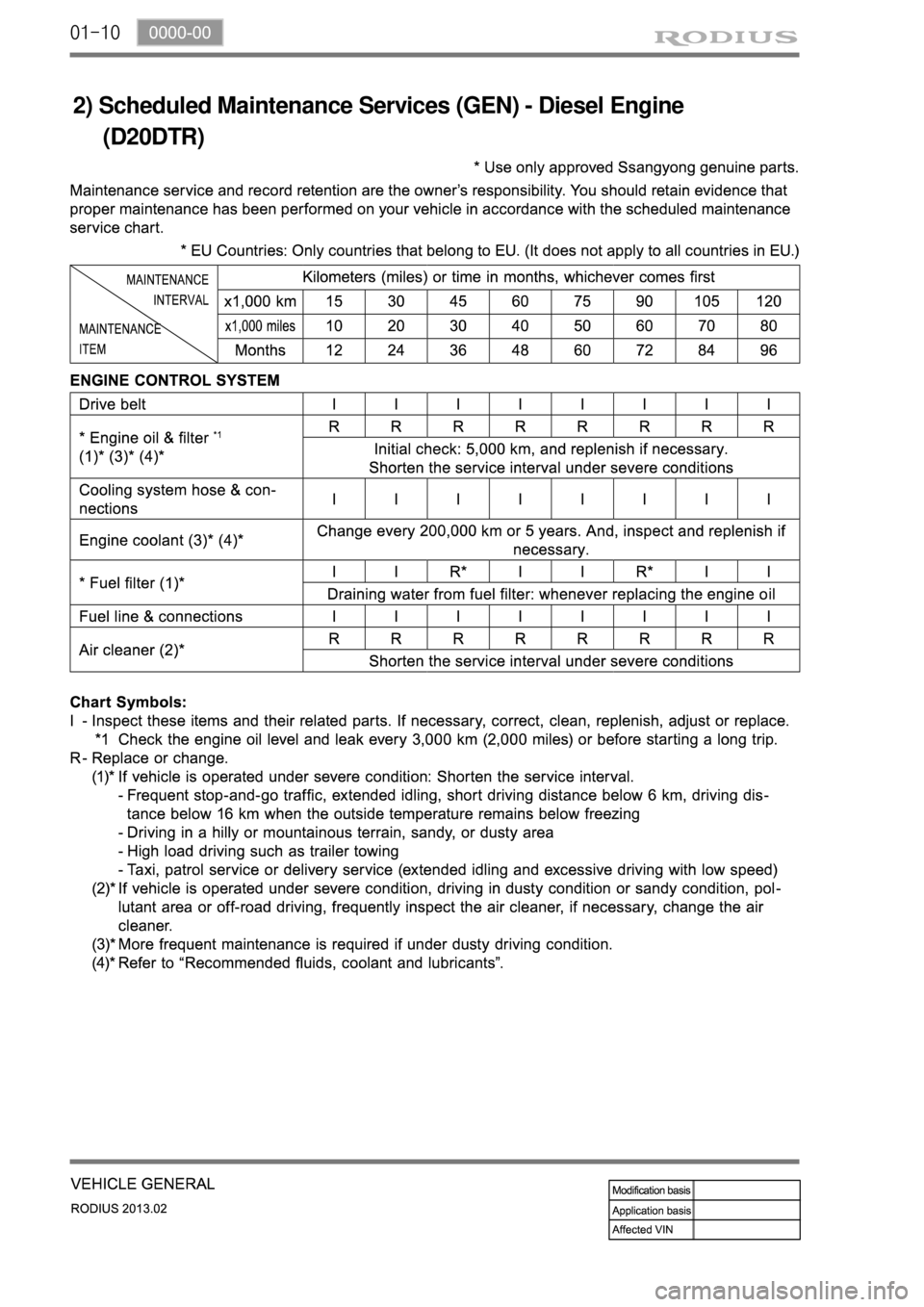
01-10
2) Scheduled Maintenance Services (GEN) - Diesel Engine
(D20DTR)
Page 128 of 796
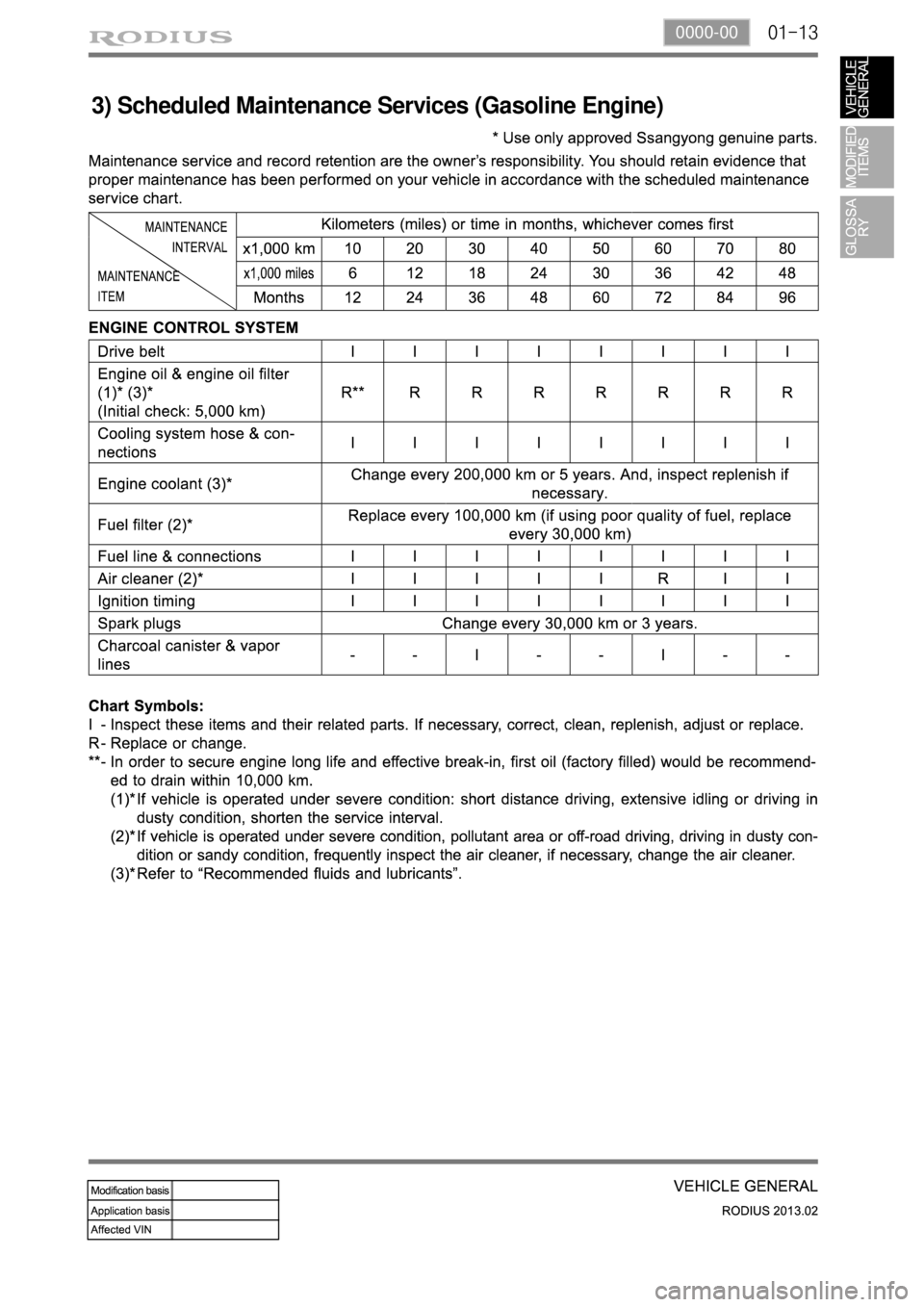
01-130000-00
3) Scheduled Maintenance Services (Gasoline Engine)
Page 147 of 796
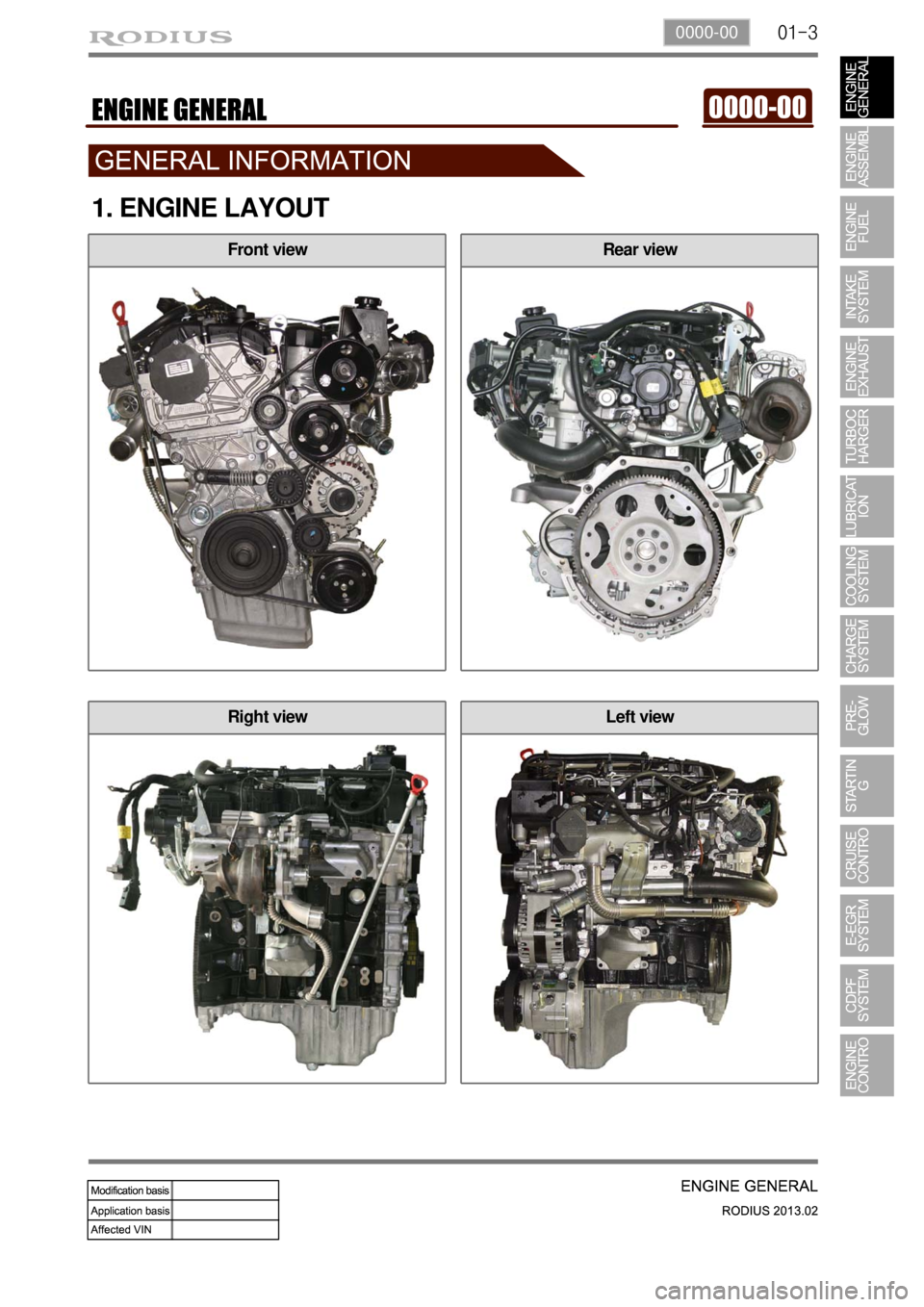
01-30000-00
Left viewRight view
Rear viewFront view
1. ENGINE LAYOUT
Page 150 of 796
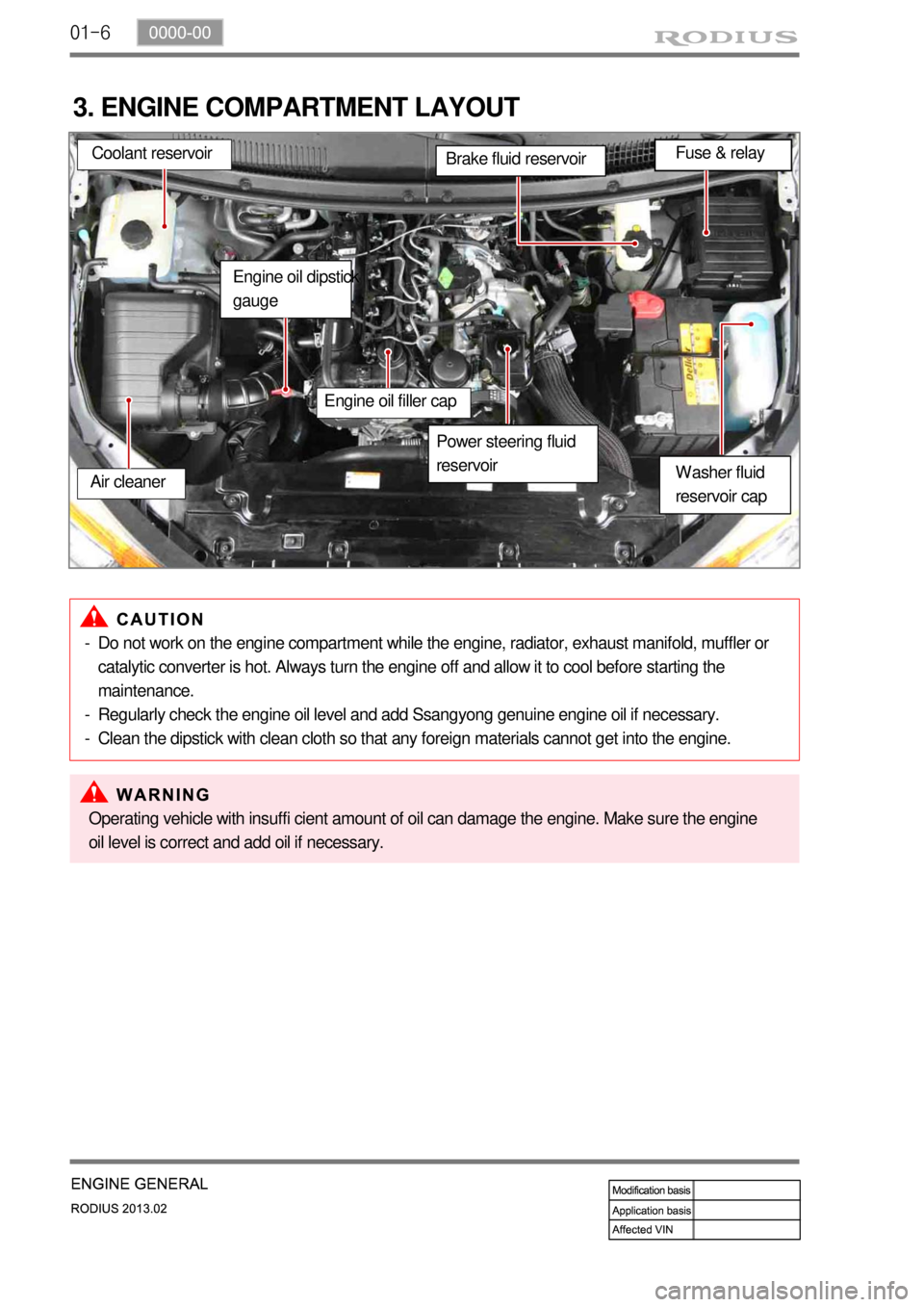
01-6
3. ENGINE COMPARTMENT LAYOUT
Do not work on the engine compartment while the engine, radiator, exhaust manifold, muffler or
catalytic converter is hot. Always turn the engine off and allow it to cool before starting the
maintenance.
Regularly check the engine oil level and add Ssangyong genuine engine oil if necessary.
Clean the dipstick with clean cloth so that any foreign materials cannot get into the engine. -
-
-
Power steering fluid
reservoirBrake fluid reservoir
Engine oil dipstick
gauge
Washer fluid
reservoir cap Engine oil filler cap
Air cleaner
Operating vehicle with insuffi cient amount of oil can damage the engine. Make sure the engine
oil level is correct and add oil if necessary.
Coolant reservoirFuse & relay
Page 151 of 796
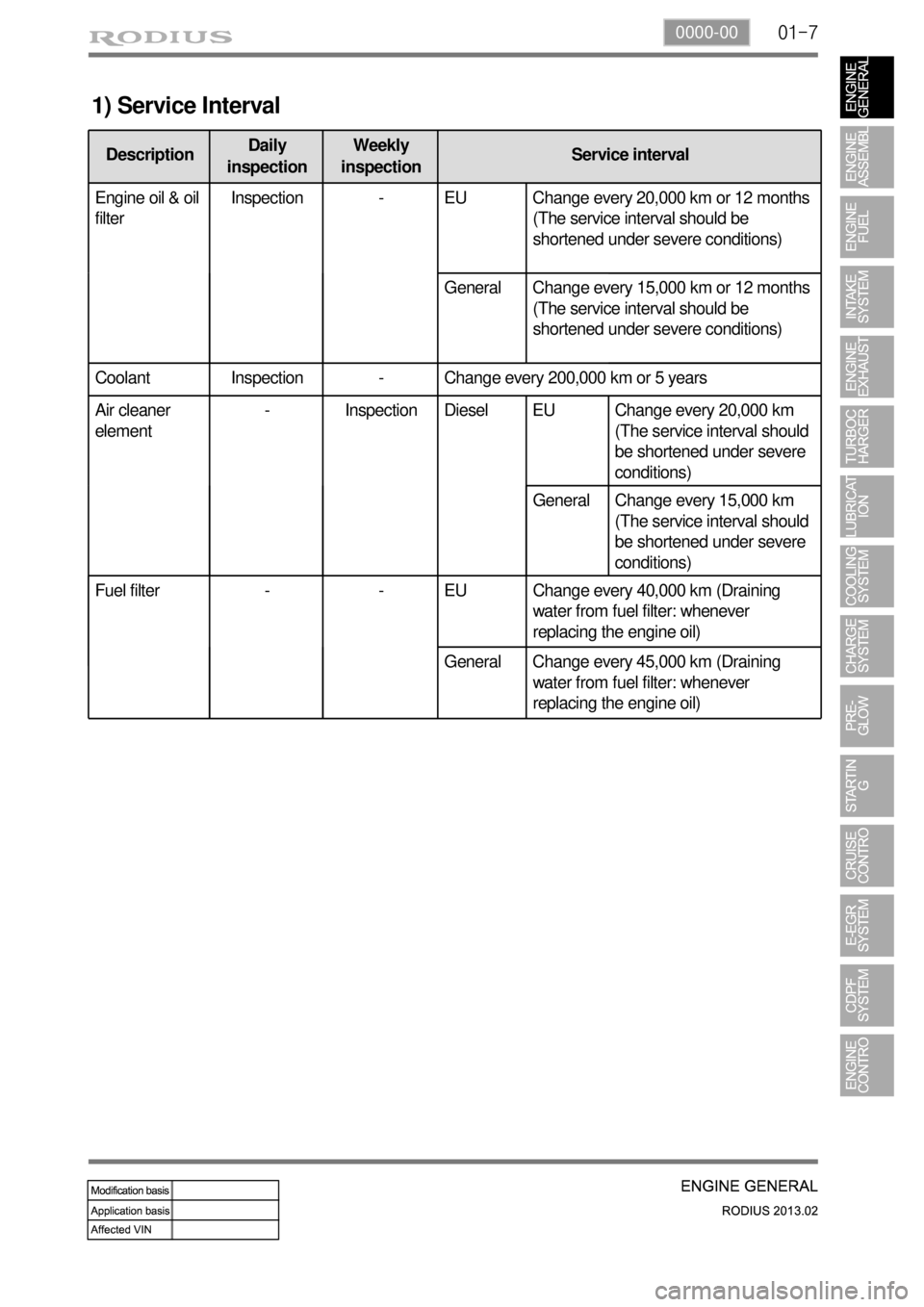
01-70000-00
1) Service Interval
DescriptionDaily
inspectionWeekly
inspectionService interval
Engine oil & oil
filterInspection - EU Change every 20,000 km or 12 months
(The service interval should be
shortened under severe conditions)
General Change every 15,000 km or 12 months
(The service interval should be
shortened under severe conditions)
Coolant Inspection - Change every 200,000 km or 5 years
Air cleaner
element- Inspection Diesel EU Change every 20,000 km
(The service interval should
be shortened under severe
conditions)
General Change every 15,000 km
(The service interval should
be shortened under severe
conditions)
Fuel filter - - EU Change every 40,000 km (Draining
water from fuel filter: whenever
replacing the engine oil)
General Change every 45,000 km (Draining
water from fuel filter: whenever
replacing the engine oil)
Page 152 of 796
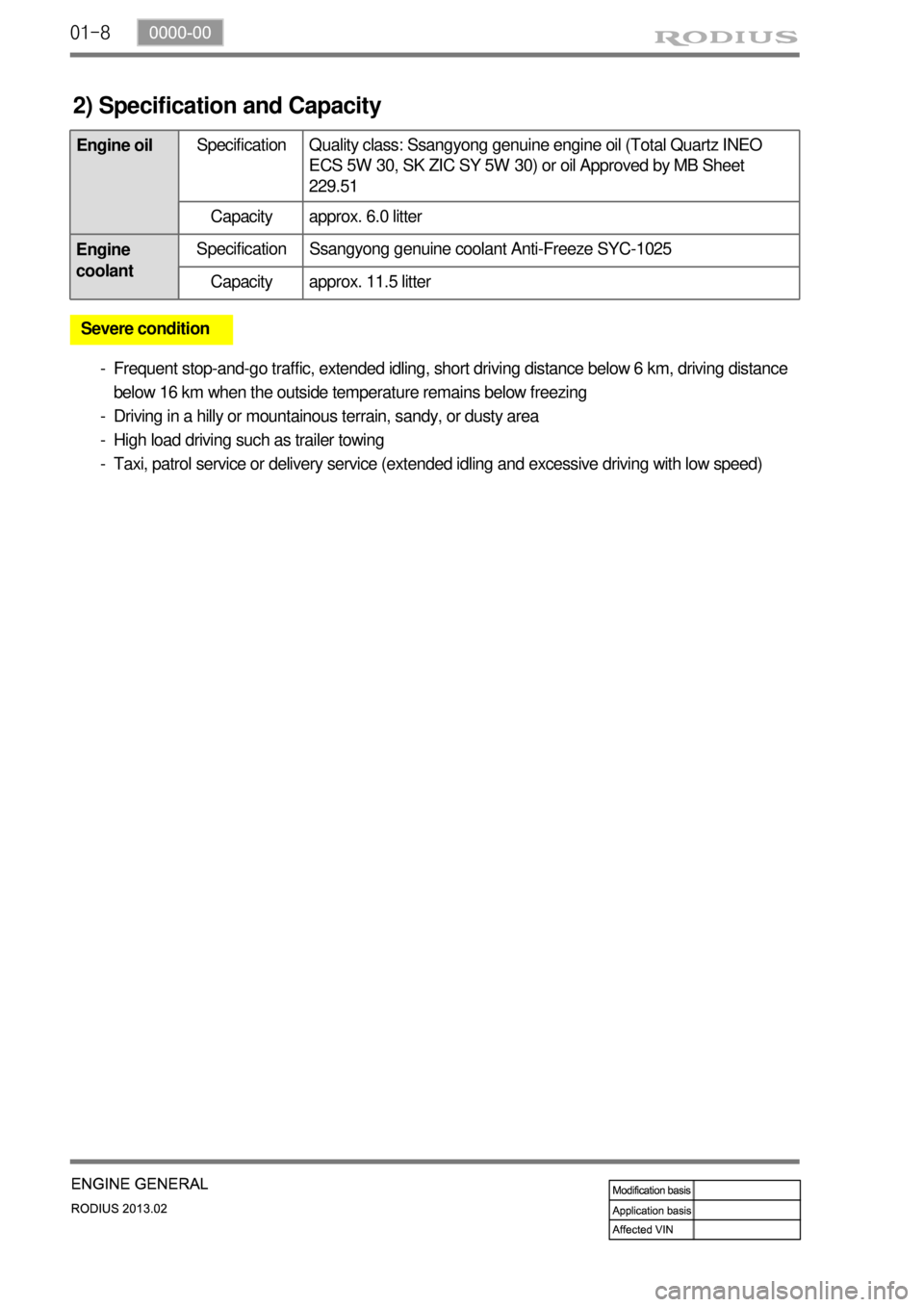
01-8
2) Specification and Capacity
Engine oilSpecification Quality class: Ssangyong genuine engine oil (Total Quartz INEO
ECS 5W 30, SK ZIC SY 5W 30) or oil Approved by MB Sheet
229.51
Capacity approx. 6.0 litter
Engine
coolantSpecification Ssangyong genuine coolant Anti-Freeze SYC-1025
Capacity approx. 11.5 litter
Severe condition
Frequent stop-and-go traffic, extended idling, short driving distance below 6 km, driving distance
below 16 km when the outside temperature remains below freezing
Driving in a hilly or mountainous terrain, sandy, or dusty area
High load driving such as trailer towing
Taxi, patrol service or delivery service (extended idling and excessive driving with low speed) -
-
-
-
Page 153 of 796
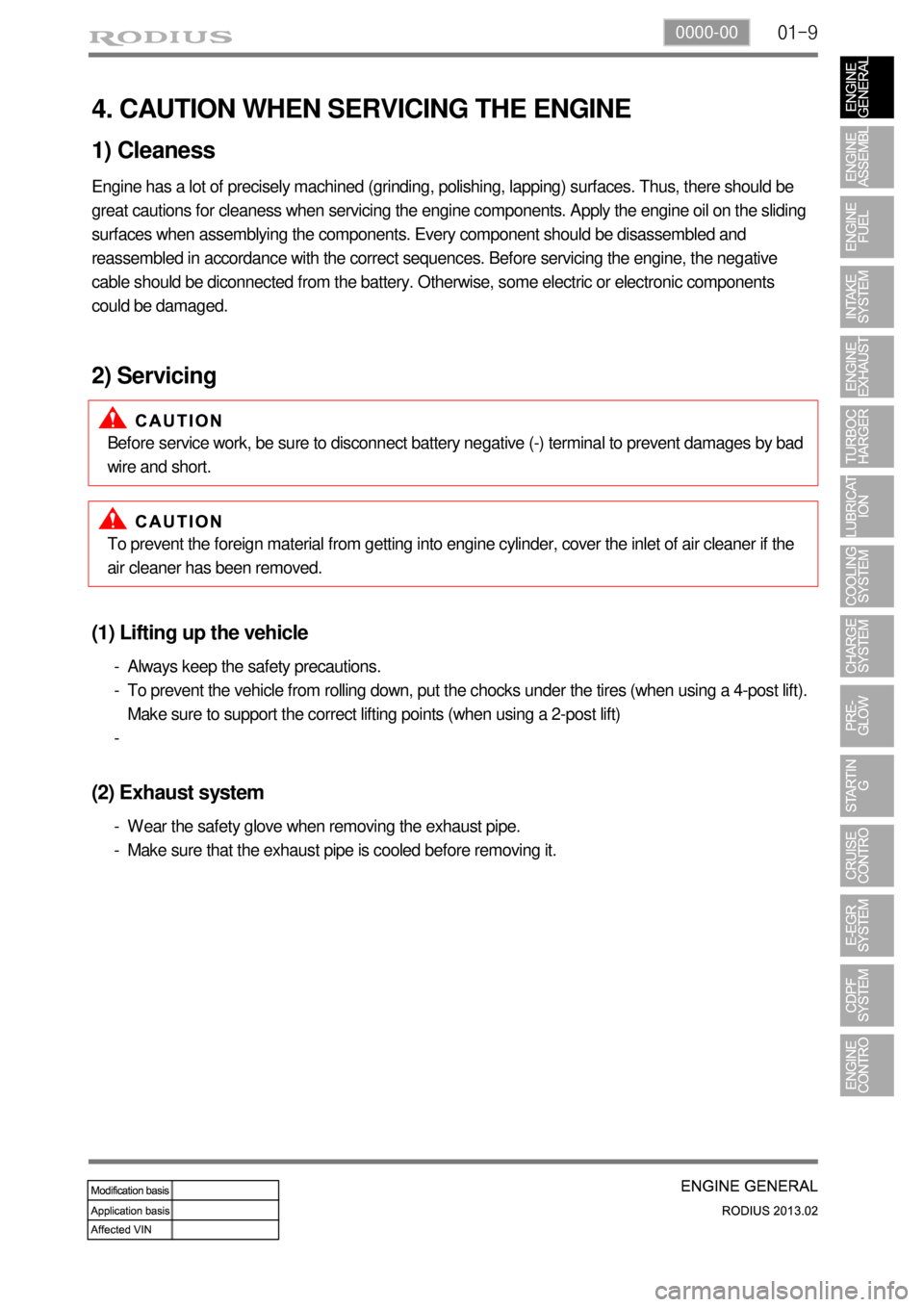
01-90000-00
4. CAUTION WHEN SERVICING THE ENGINE
1) Cleaness
Engine has a lot of precisely machined (grinding, polishing, lapping) surfaces. Thus, there should be
great cautions for cleaness when servicing the engine components. Apply the engine oil on the sliding
surfaces when assemblying the components. Every component should be disassembled and
reassembled in accordance with the correct sequences. Before servicing the engine, the negative
cable should be diconnected from the battery. Otherwise, some electric or electronic components
could be damaged.
2) Servicing
Before service work, be sure to disconnect battery negative (-) terminal to prevent damages by bad
wire and short.
To prevent the foreign material from getting into engine cylinder, cover the inlet of air cleaner if the
air cleaner has been removed.
(1) Lifting up the vehicle
Always keep the safety precautions.
To prevent the vehicle from rolling down, put the chocks under the tires (when using a 4-post lift).
Make sure to support the correct lifting points (when using a 2-post lift) -
-
-
(2) Exhaust system
Wear the safety glove when removing the exhaust pipe.
Make sure that the exhaust pipe is cooled before removing it. -
-
Page 154 of 796
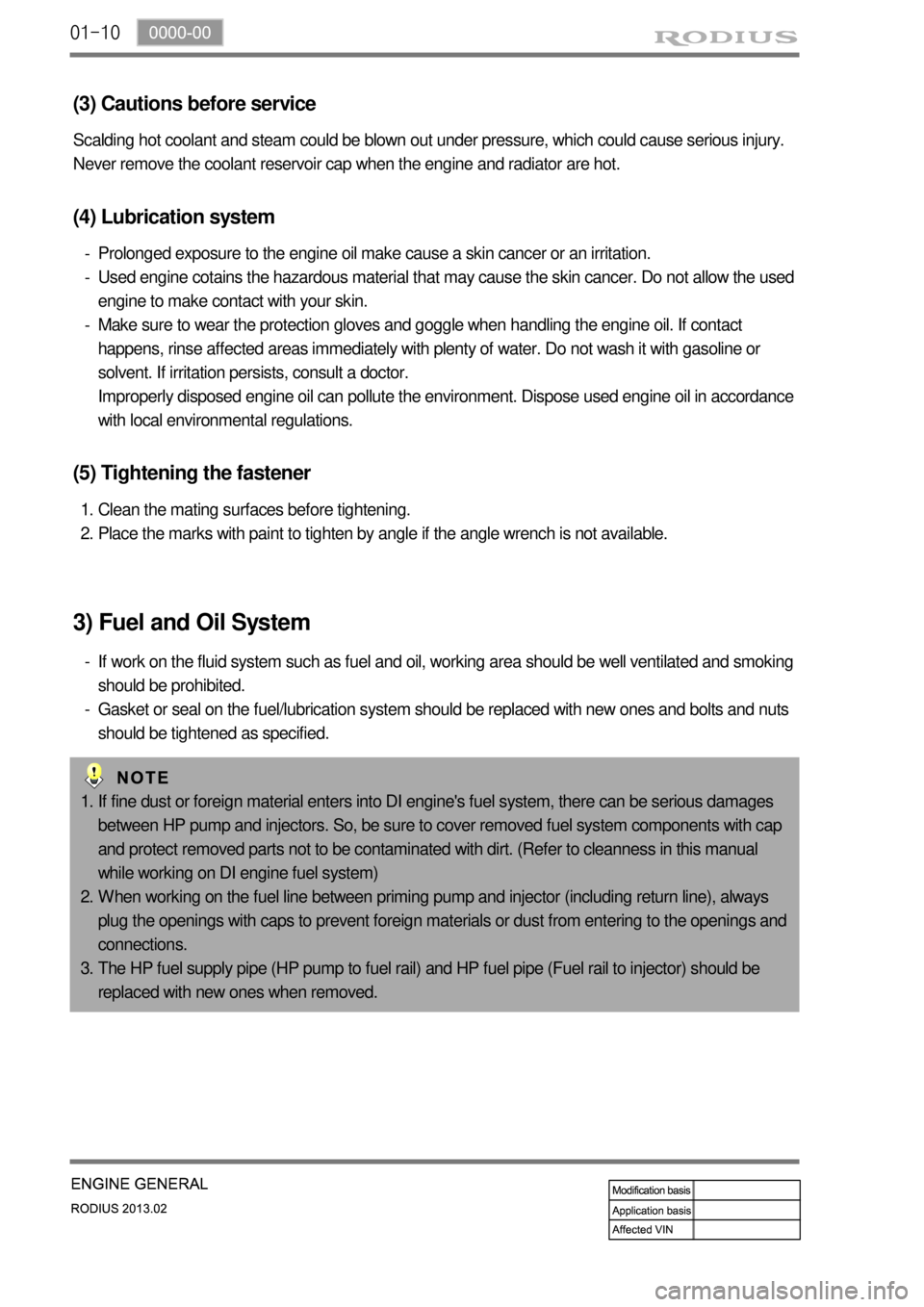
01-10
(3) Cautions before service
Prolonged exposure to the engine oil make cause a skin cancer or an irritation.
Used engine cotains the hazardous material that may cause the skin cancer. Do not allow the used
engine to make contact with your skin.
Make sure to wear the protection gloves and goggle when handling the engine oil. If contact
happens, rinse affected areas immediately with plenty of water. Do not wash it with gasoline or
solvent. If irritation persists, consult a doctor.
Improperly disposed engine oil can pollute the environment. Dispose used engine oil in accordance
with local environmental regulations. -
-
-
(5) Tightening the fastener
If fine dust or foreign material enters into DI engine's fuel system, there can be serious damages
between HP pump and injectors. So, be sure to cover removed fuel system components with cap
and protect removed parts not to be contaminated with dirt. (Refer to cleanness in this manual
while working on DI engine fuel system)
When working on the fuel line between priming pump and injector (including return line), always
plug the openings with caps to prevent foreign materials or dust from entering to the openings and
connections.
The HP fuel supply pipe (HP pump to fuel rail) and HP fuel pipe (Fuel rail to injector) should be
replaced with new ones when removed. 1.
2.
3. Scalding hot coolant and steam could be blown out under pressure, which could cause serious injury.
Never remove the coolant reservoir cap when the engine and radiator are hot.
(4) Lubrication system
3) Fuel and Oil System
If work on the fluid system such as fuel and oil, working area should be well ventilated and smoking
should be prohibited.
Gasket or seal on the fuel/lubrication system should be replaced with new ones and bolts and nuts
should be tightened as specified. -
-Clean the mating surfaces before tightening.
Place the marks with paint to tighten by angle if the angle wrench is not available. 1.
2.